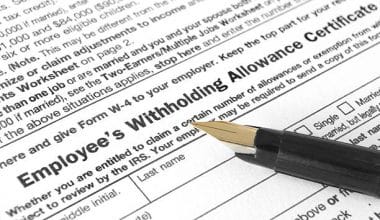The IRS’s W-4 form, officially known as the “Employee’s Withholding Certificate,” instructs employers how much tax should be deducted from each employee’s paycheck. Businesses utilize the W-4 to calculate some payroll taxes and remit the taxes on behalf of employees to the IRS and the state (if applicable). If you already have a W-4 form on file with your company, you do not need to fill out the new one. Moreover, you are not required to complete a new W-4 annually. But, you’ll most likely need to complete the new W-4 if you start new employment or wish to change the withholdings at your current position. It’s a fantastic justification to examine your withholdings in any case. This article explains what to claim on W4 if single and when married. It also further sheds more light on what to claim on W4 to not Owe taxes. Enjoy the ride!
What to Claim on W4
You will notice that the W-4 form, which each employee must complete to specify the amount of taxes to be withheld from each paycheck, has changed if you are transferring employment and haven’t done so recently. The Internal Revenue Service (IRS) claims that revising the form, has improved the system’s accuracy and transparency. If you are not switching jobs and there is no cause to revise your W-4, you do not need to fill out a new one. The one that is currently on file with your workplace may still be used.
In 2020, the W-4 form underwent a significant redesign and was reduced to five pieces from its previous seven. The amount of tax your employer will deduct from your paycheck depends on how Form W-4, Employee’s Withholding Certificate, is completed. Along with the money it deducts from your paycheck, your employer transmits your name and Social Security number to the IRS. When you complete your yearly tax return, you must include your withholding as part of the annual income tax payment. The W-4 form requests identifying information such as your name, address, and Social Security number for this reason.
What on the Form W-4 Has Changed
The opportunity to claim personal allowances is gone from the W-4 form as it stands right now. In the past, a W-4 included a Personal Allowances Worksheet to assist you in determining how many allowances to claim. Employers would deduct less from your salary if you claimed more allowances; more would be deducted if you claimed fewer allowances.
What to Claim on W4 if Single
Wondering What to Claim on W4 if Single? Here is a guideline for it:
- will probably yield a very large tax refund
- Will probably yield a little tax refund
- Gets you near to withholding the precise amount of tax due; you might only owe a little sum.
When you start a new employment, you are given a W-4 form. It’s generally in new hires’ welcome packages and helps decide tax withholding. Filling it out can be stressful since how are you meant to understand what it all means? What ought you to say? Perhaps you want to be on the safe side, so you’ll pay more in taxes now and wait for a return. You might wish to pay as little tax as possible and try to maximize your current paycheck by trying to acquire as much money as possible now. Your allowances play a role in this.
Allowances
As you list your allowances on your W-4, it’s a crucial tax document. A tax withholding allowance, according to Investopedia, “refers to an exemption that lowers the amount of income tax that an employer withholds from an employee’s paycheck. To determine their personal withholding amount, American workers often fill out IRS Form W-4, Employee’s Withholding Allowance Certificate. The business then utilizes the W-4 data to calculate how much of an employee’s income should be deducted from their paycheck and sent to the appropriate taxing authorities.
The more allowances you request, the less money the government will deduct from your paycheck as taxes. Your paycheck will be taxed more heavily if you receive fewer allowances. Your filing status determines what you write down. What then should a single person do? According to Investopedia, “if you’re single, have no kids, and plan to take the standard deduction, you can claim one withholding allowance for yourself and a second if you’re single and working one job, for a total of two.”
On W-4 page 3, the IRS provides a personal allowance spreadsheet to assist you to decide. The IRS’s withholding calculator can help you choose the right option and understand its consequences.
Liberty Tax advises single people with 9-to-5 jobs to declare one as their tax withholding. Your allowance can result in a refund. If you make no claims, the maximum amount will be deducted from your pay, and you’ll probably get a refund. So, getting one may be a good way to save money and stay within tax laws. Without a doubt, speak with a tax expert for personalized guidance specific to your circumstances.
When to Change It Up
You can’t just set your tax withholding and forget about it. You should adjust your tax withholding if you move to employment, get married, have a child, or do any of these things. Change your tax withholding if you’re dissatisfied with whether you received a refund or not during tax time. Hence, track your W-4 and tax withholdings if your life changes significantly.
What to Claim on W4 When Married
If you claim no allowances or one, you’ll probably get a large tax refund. There will probably be a little tax refund if you claim two allowances. If you wish to get near to withholding your precise tax requirement, claim two allowances for you and your spouse, as well as allowances for however many dependents you have (thus, for example, if you have two dependents, you would want to claim four allowances).
When filing a combined return with two allowances, a married couple with one source of income is advised. If you support your children under 19, you can claim them as dependents on your tax return.
What to Claim on W4 to Not Owe Taxes
Calculating your tax obligation for the year is not too difficult if you are a paid worker with stable employment. Your projected annual income is known. Several Americans fall outside of the group as mentioned earlier. They are independent contractors, hold down many jobs, are paid hourly, or rely on commissions, bonuses, or gratuities. If this is you, estimate your profits based on historical performance and the year thus far.
#1. Use a Calculator Online
Online calculators that are free to use include those for income taxes and paychecks. The calculator will then display your federal tax burden per paycheck or per year after you enter your gross income, frequency of payments, federal filing status, and other pertinent data.
This method is simple, and the outcome will be roughly accurate, but it might not be perfect because your real tax due may rely on other factors, such as whether you itemize deductions and which tax credits you claim.
#2. Use a Tax Withholding Calculator
For those with more complicated tax situations, the IRS website’s tax withholding estimator can be quite helpful. Using this tool takes longer than using a regular calculator, but the results are more precise. It will enquire about things like your eligibility for child and dependent care tax credits, if you contribute to a tax-deferred retirement plan or Health Savings Account, how much you put toward one, and how much federal income tax was deducted from your most recent paycheck, among other things.
#3. Complete a Model Tax Return
Another choice is to finish a sample tax return for the year using tax software or by obtaining the necessary paperwork from the IRS website and manually filling them out. This method will take the longest but give you the most accurate tax liability estimate.
#4. Change the Tax Withholding
Finding out how much has to be withheld from your paychecks each pay period in order to reach—but not exceed—that goal by December 31 comes after knowing the entire amount of federal taxes you’ll owe. After that, complete a fresh W-4 form in accordance. You don’t need a new W-4 form from your employer’s HR department. On the IRS website, you can print one for yourself.
#5. Should Your Employer Not Be Withholding Enough
The W-4 form lets you choose how much extra tax to deduct each pay period. If you have already paid less than you should have, deduct the amount you expect to pay by the end of the year, based on your current level of withholding, from the total amount you will owe. The result is then divided by the number of pay periods left in the year. You can then calculate how much extra you want deducting from each paycheck based on that information. Although the results won’t be as exact, you could possibly claim fewer withholding allowances.
#6. If You’ve Been Paying Too Much
Try raising the amount of withholding allowances you claim on the W-4 unless you anticipate receiving a sizable refund. Choosing the precise number can be challenging. It is easy to use a paycheck calculator to enter various numbers of withholding allowances until it reaches the amount that is closest to the federal tax that you want to have deducted from future pay periods.
Keep in mind that the IRS requires you to have a justifiable cause for any withholding allowances you claim. The organization doesn’t want you tottering around with its paperwork to put off paying taxes until the very last minute. If you intentionally withhold your W-4, you may be prosecuted. Additionally, it may mandate that the appropriate amount be withheld by your employer, giving you no say in the matter.
The 5 Steps on How to Fill a W-4
Filling out a W-4 is simple if you are single or married to someone who is not employed, have just one job, have no dependents, and are not claiming any tax credits or deductions (other than the standard deduction). Simply fill out your name, address, Social Security number, and filing status before signing and dating the form.
On the other hand, your tax situation is more complicated if you have dependents, a spouse with income, or if you intend to claim any tax credits or deductions, in which case you’ll need to supply more details.
#1. Personal Information
Your name, address, filing status, and Social Security number should be provided. Your annual income tax bill can be properly credited when your employer sends the funds deducted from your paycheck to the IRS using your Social Security number.
#2. Account for Multiple Jobs
If you file jointly with your spouse and work numerous jobs, follow the standards for more accurate withholding.
- Complete the W-4 steps 2 through 4(b) for the position with the highest compensation. The W-4s for the other occupations should be blank in that section.
- Check box 2(c) if you (or your spouse) work two jobs and make about the same at each. The catch is that you must complete both W-4s.
- There are a few solutions available to you if you don’t want to disclose to your employer that you have a second job or that you receive income from other non-work sources: You can tell your employer how much more tax should be deducted from your paycheck on line 4(c). Alternatively, don’t factor the extra revenue into your W-4. You should transmit your own estimated tax payments to the IRS rather than having the tax deducted from your paycheck.
#3. Add Dependents
Step 3 determines if you qualify for the Child Tax Credit and other dependent credits. Single taxpayers earning under $200,000 and married couples earning under $400,000 can claim the Child Tax Credit.
Although the IRS’s definition of a dependent is technically somewhat complicated (see IRS Publication 501 for details), the short version is that a dependent is any eligible child or relative who lives with you and is financially supported by you. To determine the total amount owed, increase the number of eligible children under age 17 by $2,000 and the number of other dependents by $500. Line 3 should be updated to reflect the two totals.
#4. Refine Your Withholdings
While filing your taxes, you can make a note if you want additional tax withheld or if you plan to take deductions other than the standard deduction.
#5. Sign and Date Form W-4
Once you sign the form, it becomes legally binding. Always keep in mind that you only need to complete the new W-4 form if you start a new employment or if you wish to modify the amount of taxes deducted from your salary.
Is It Better to Claim 1 or 0?
You can choose how much tax you want to be deducted from your pay each paid month by entering a “0” on line 5. Less tax will be deducted from your paycheck each pay period if you choose to claim 1 for yourself instead.
How Do I Decide What to Claim on My W4?
Understanding how many allowances you should claim is a key component of understanding how to complete your W4. Your filing status, the number of jobs you hold, and whether or not you have dependents all play a role in this. A single person with one job, for instance, will claim fewer allowances than a married person with kids.
Should You Claim 0 on Your W4?
If someone else lists you as a dependent on their tax return, you should make no allowance claims on your IRS W4 tax form. (For instance, supposing you’re a college student who is the legal claimant of your parents.
Should I Claim 1 or 2 on My W4?
If you’re single and have no dependents, you can only claim one allowance; if you’re married and have one source of income, you should submit a joint return and claim two allowances. If you provide for them financially and they are under the age of 19, you can also list your children as dependents on your tax return.
Do I Claim Myself as a Dependent on W4?
No. Tax forms do not allow you to list yourself as a dependent. Only your eligible dependent children and eligible dependent relatives are eligible for dependency exemptions. A personal exemption is something you can claim on your tax return.
How Do I Fill Out a W4 to Get More Money?
Change “Extra withholding” line 4(c) on Form W-4 to raise the amount of federal taxes withheld from each paycheck you get if you want a larger refund.
Final Thoughts
Individuals are required to make quarterly tax payments to the IRS, thus it’s crucial that they submit a completed W-4 form. Underpayment of taxes throughout the year might result in a hefty tax bill in April if adequate withholding is not performed. Your monthly budget will be more constrained than necessary if too much tax is withheld, though. Also, instead of saving or making an investment with that money, you’ll be lending it to the government at no interest. Once you complete your tax return and receive a refund the next year, you will receive your overpaid taxes back.
When that happens, the cash could feel like a windfall, and you might not spend it as prudently as you would have if it had been paid out gradually with each paycheck.
Related Articles
- ALLOWANCES: What It Is, Withholding, W4 & What to Claim
- Exemptions On Taxes: Tax Exemption Explained!
- WITHHOLDING ALLOWANCES: What It Is, How It Works and to Calculate It
- FIT TAX: What Is Fit Tax on My Paycheck?
- HOW TO PAY LESS TAXES: Simple Ways to Pay Less Taxes Legally






